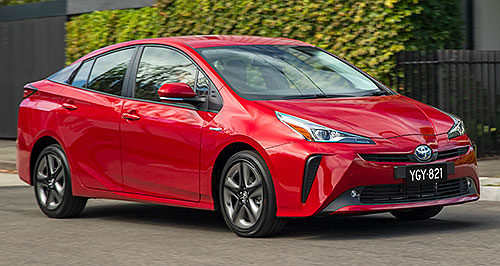Make / Model Search
News - Market Insight - Market Insight 2021Market Insight: Toyota cracks 200,000 hybrid salesGoing green: Hybrids proved a hit with buyers concerned about the environment but more choose them for fuel efficiency and quiet operation Slow start for hybrids in 2001 but many Toyota buyers now opt for petrol-electricGallery Click to see larger images 19 Jul 2021 By NEIL DOWLING MORE than 210,000 Australian owners over 20 years attest to the practicality and durability of the once-derided hybrid passenger car format introduced most famously under the Toyota Prius label.
So successful has the Prius hybrid become that it now has spawned 10 models, from the Yaris to C-HR, Camry to Kluger and in recent years, a successful version of the RAV4.
Hybrids have been around since at least 1889 when the Patton hybrid railcar was shown – and commercially sold from 1891 – and the most important hybrid, the petrol-electric Armstrong Phaeton of 1896 before the Lohner-Porsche Mixte of 1900.
Clearly, there is a whopping leap from 1900 through to the hybrid becoming acceptable as an alternative passenger car powertrain and commercial success with the Prius a century later.
Other manufacturers have been involved in testing hybrids – General Motors, Audi, Ford, Alfa Romeo and Volvo among them – but Toyota provided the inspiration that led to hybrids sharing showroom space with conventionally-powered models from the same brand.
After the Prius became the world’s first mass-produced hybrid car in 1997, the Honda Insight (2000), Ford Escape (2004 in the US market) and Honda Civic (2003) were the ones that followed Toyota’s lead. In Europe, Audi’s diesel-electric A4 Duo plug-in hybrid went on sale in 1997 but was quickly dropped.
Now Australian sales of Toyota hybrids have passed 200,000 – equivalent to an average of 10,000 a year since 2001 but growing exponentially – with the total to the end of June this year at 210,817 units.
Toyota said it took until mid-2018 for it to pass 100,000 hybrid deliveries in Australia, almost 17 years after the original Prius hybrid was launched here in 2001. Before the middle of this decade, the company could be selling that many per year.
Over the 20 years of Toyota hybrids, the Camry has proven the most popular in Australia with 75,998 sales, followed by the RAV4 (48,632), Corolla (40,143) and Prius (20,778).
So far this year, Toyota is on track to overtake its annual sales record of 54,335 hybrids achieved last year.
Total hybrid sales in this year to the end of June of all hybrid brands and models hit 36,658 passenger cars, SUVs and light-commercial vehicles.
In the past six months alone, Toyota has sold 34,036 hybrids – at 93 per cent of the total, clearly the lion’s share – and if that run-rate continues it could approach 75,000 hybrids by the end of this year.
More than 50 per cent of the sales of Toyota’s RAV4, Camry, Corolla and Yaris Cross are hybrids.
While Camry buyers showed the biggest preference to hybrid power with 79.5 per cent (4979 sales) choosing it over the petrol-only version, buyers of the Yaris Cross are also converts with 61.4 per cent (or 2588 sales) opting for the hybrid.
Corolla hatch and sedan have also favoured hybrids with 7906 cars sold in this year to date, representing 57.2 per cent of the model's total volume.
The displacement of petrol-only models has grown rapidly with total Toyota hybrid sales doubling in only the past three years, mainly on growing acceptance of the technology, a clearer consumer understanding of the ownership cost benefits, and the broadening of model choices.
Also, rollout of Toyota hybrids directly equates to the sales curve. In 2011, Australia received the Camry hybrid and a year later, the Prius hatch was joined by the smaller C (city car) and larger V (seven-seat wagon) variants.
This started the creep into hybrid versions of the Corolla hatch (2018) and sedan (2019), and the RAV4 (2019) that became the first hybrid to be the top-seller in one month, August 2020, when 4405 were sold.
Along with petrol versions, the Yaris hybrid went on sale in late 2020, then the Yaris Cross hybrid (early 2021).
This month Toyota expanded its hybrid offerings with the Kluger, presenting a seven-seat family car with a petrol engine and electric motor, capable of suburban fuel economy of a miserly 5.6 litres/100km (6.7L/100km on test) – compared with a claimed 8.7 L/100km (11.8L/100km on test) for the non-hybrid V6 petrol.
Though the hybrid tech adds $2500 to the petrol equivalent, there’s a saving of about $600 a year (15,000km) that appeals to families aiming to minimise weekly costs. The hybrid upgrade can pay itself in about four years, much quicker if the vehicle is used in a slow-speed urban environment where the electric motor does more of the work.
Toyota Australia vice president sales, marketing and franchise operations Sean Hanley said Toyota hybrids had become a mainstay on Australian roads.
“Our combination of HEV technologies deliver performance, with great fuel economy and low emissions, that is resonating with buyers more than ever,” he said.  |
Click to shareMarket Insight articlesResearch Market Insight Motor industry news |










Facebook Twitter Instagram